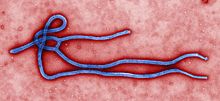Ebola- A virus that brings fatal illness in human beings. With the outbreak of this virus in this year, the death toll has raised to approximately 1400 globally. Ebola is a virus that gets transmitted into people through infected animals or humans. It is mainly present widely in African countries. History of this Ebola virus goes back to 1976 in Africa, killing around 300 humans. As it is a contagious disease, people traveling from these parts to several parts of the world has a chance of spreading the virus. WHO(World Health Organization) has instructed many countries to create awareness among people and also to screen the passengers who travel from affected countries in respective airports itself.

Symptoms:
The person infected with this virus will develop fever, influenza, headache, joint pains followed by vomiting and diarrhea. Some may have sore throat, chest pain etc. But later stages of this disease if not diagnosed earlier will lead to bleeding within the body and also externally. This results in loss of blood and leads to death within 3-4 weeks.
Diagnosis:
Ebola virus can be identified from infected person's blood samples. The collected samples will be diagnosed in PCR (Polymerase Chain Reaction) test and ELISA(Enzyme Linked Immunosorbent Assay) test.
Vaccine:
No vaccines are found till now to control or erase this killer disease.
Prevention:
By following basic hygienic habits we can almost avoid Ebola affecting our habit.
- Hand wash should be done regularly with soaps or sanitizers.
- Sterile equipments should be used to avoid any virus getting inside our body.
- While treating Ebola affected patients, almost care should be taken by wearing gloves, masks,gowns etc.
- Quarantining the areas which are affected by Ebola reduces effective spread of the disease.
- Ebola virus cannot sustain heat. It gets eradicated at minimum boiling temperature
Treatment:
There is no specific treatment to kill the virus. But earlier diagnosis and treatments are given such a way that the affected person can have increased chance of survival. Patient will be provided with lot of fluids and to avoid dehydration. Also pain killers will be given to manage pain in the joints.
photo courtesy: Wikipedia